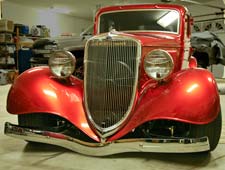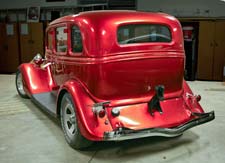












1934 Ford Model B |
|||
| Classic and Hot Rod Cars And Their Stories | |||
| 1934 Ford Model B | |||
I have elected to finish up the year with this particular car for two reasons, I've always liked the body style and my dear friend, the late and, yes, great CW Jones built this one.The Ford Model B was produced starting with model year 1932 and ending with 1934. It was a much updated version of the Model A and was replaced by the 1935 Ford Model 48. Strictly speaking, the Model B was a four-cylinder car with a much improved version of the Model A engine, but Ford also began producing a very similar car with Ford's new flathead V-8 engine. The V-8 car was marketed as the Model 18, although it is commonly called the Ford V-8 and, other than the engine, is virtually identical to the Model B, both mated to a manual 3-speed transmission and running Firestone 525/550x17 tires. Up to this time, Ford had produced only one "model" at a time with range of body options and retained the idea of a single basic platform, despite the engine choice and two associated model designations. (This explains why the name "Ford V-8" by itself was sufficiently descriptive in the early 1930s; it was the Ford with a V-8, unlike in later decades, when various models had so many options.) Model B and Model 18 Fords came in a large variety of body styles: two-door roadster, two-door cabriolet, four-door phaeton, two-door and four-door sedans, four-door “woodie” station wagon, two-door Victoria, two-door convertible sedan, panel and sedan deliveries, five-window coupe, a sport coupe (stationary soft top) and the three-window deluxe coupe. Prices ranged from $495 for the roadster and the coupe's $490 to the $650 convertible sedan. Production totals numbered from 12,597 for the roadster to 124,101 for the two-door sedan. 298,647 V8-powered Bs sold in 1932, and except for the fact Ford could not keep up with demand, the four-cylinder B would have been a disaster: dealers switched customers to them from the V8, and even then sold only 133,539, in part because the V-8 cost only $10 more. Today, the roadster and coupe are most sought after, as these body styles are the most popular for streetrods and intact classic examples have become rare. The Model 18 was the first low-priced, mass-marketed car to include a V-8 engine, an important milestone in American automotive history. The V-8 was rated at 65 hp when introduced, but power increased significantly (85 hp) with improvements to the carburetor and ignition in later years. This engine choice was more popular than the four-cylinder, which was essentially a variant of the Model A engine with improvements to balancing and lubrication. In both models, the fuel tank was located in the lower rear of the car, as is typical in modern cars, rather than in the cowl as in the Model A and late Model T, requiring Ford to include an engine-driven fuel pump rather than rely on gravity feed. Today, the 1932 Model B is a highly collectible car that people will pay thousands of dollars to restore to exact original style. During the WWII period, the Model Bs and V-8s were frequently altered into hot rods. Since the 1970s, 1932 bodies and frames have been reproduced either in fiberglass or lately in steel, which has helped resolve bodywork shortages, and increased the number of "rods" being created or restored. Being the perfectionist, when CW built a car, it was always a work of art. The original '34s had a bowed wooden top kind of like a moon roof, prone to rotting (he welded a solid steel top on the car). Under-the-hood improvements included a Ram Jet 350 injected crate motor, a 700R4 transmission, a custom radiator, and air conditioning. The interior was completely updated including a custom dash with TCI gauges, a GPS-Radio-CD system, seats, carpet, and headliner. CW and Paula originally bought the car in Salinas in June 2007 where it had been sitting in a barn for years and looked it. He finished his car project in less than two years. |
|||
Note: All Images And Stories On This Site Are Copywrited. Use Of Any |
|||
 Great Pricing & Selection of Cameras and Accessories: Top Camera Mall |
|||
|
|||



